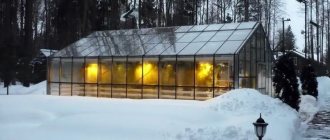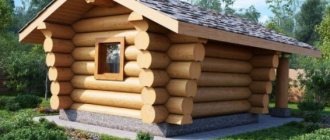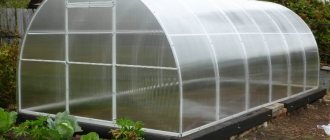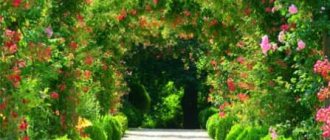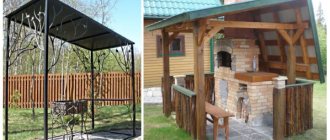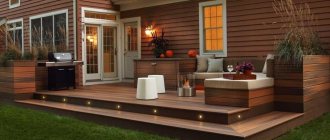Years go by, but man continues to engage in farming, no matter where he is. But since the climate varies from place to place, in some cases it is necessary to use greenhouses. A large number of materials are suitable for their construction, but polycarbonate greenhouses have gained the most popularity.
Polycarbonate greenhouses - how to choose
Climatic features
When choosing, you should take into account the climatic characteristics of the regions of use. The main climatic characteristic is the snow load for the region. It is measured in kg per square meter. m. Resistance to snow loads is almost always indicated in the product passport.
Snow load in some regions of the Russian Federation is:
- Crimea – 80 kg per sq. m;
- Krasnodar, Stavropol Territory - 100 kg per sq. m;
- Moscow, Veliky Novgorod, St. Petersburg, Yekaterinburg - 150 kg per sq. m;
- Perm region, Nizhnevartovsk – 250 kg per sq. m;
- Petropavlovsk-Kamchatsky - 350 kg per sq. m.
Video description
Those for whom aesthetics are important should also think about the design of the structure.
You can see a selection of inspiring greenhouses in this video: When choosing a covering, experts recommend taking into account the climatic conditions of the region, the crops that will be grown, and individual preferences. You need to weigh the pros and cons, take into account the available footage and set the budget to choose the best option. By contacting us for a consultation, you will receive answers to all your questions.
A designer greenhouse will be an excellent decoration for the site. Source houzz.com
Classification according to the structure and material of frame structures
I will describe several of the most popular options.
Galvanized thin-walled profile
This frame is light in weight, does not corrode, is easy to assemble, and is inexpensive. The main disadvantage is low mechanical strength. It can be used in regions where snowfalls are not heavy and snow cover does not last long or is completely absent (Crimea, Krasnodar and Stavropol Territories).
Closed-loop galvanized or painted steel pipe
A frame made of steel pipes with a rectangular or square cross-section has fairly high mechanical strength (the optimal cross-section is 40x20 mm, with a metal thickness of 1 mm).
This frame can be used in regions with average snow load (Moscow, St. Petersburg, Veliky Novgorod, Yekaterinburg). The main disadvantage is the susceptibility to corrosion in places where locks, windows are installed, in places where shelves are attached, etc.
For areas with frequent and heavy snowfalls, long and snowy winters, you should purchase structures with a double frame or an increased cross-section (60 x 20 mm) and a frame pipe thickness of at least 1.2 mm (Perm region, Nizhnevartovsk, Petropavlovsk-Kamchatsky).
Aluminum pipe
The aluminum frame is resistant to external influences and corrosion. It is light in weight. Significant disadvantages include high heat transfer (cools quickly at night) and high cost.
User voting
Which greenhouse would you choose or recommend?
Volya Dacha Optima
14.29 % ( 2 )
Bastion Premium
35.71 % ( 5 )
Kremlin Suite
7.14 % ( 1 )
Will Yota
7.14 % ( 1 )
Uralochka
7.14 % ( 1 )
Hacienda-4 Standard
14.29 % ( 2 )
Orange Droplet
7.14 % ( 1 )
Innovator Droplet
7.14 % ( 1 )
Dachna Strelka
0.00 % ( 0 )
Classification by type of polycarbonate used
The most important characteristics of polycarbonate include:
- sheet thickness;
- the presence of a light-protective layer;
- density of polycarbonate.
Sheet thickness
Cellular polycarbonate comes in thicknesses of 4, 6, 8 and 10 mm. In most cases, a sheet thickness of 4 mm is sufficient. Polycarbonate of thinner thickness has insufficient strength, which can lead to damage to the roof during strong winds and precipitation.
The use of thicker polycarbonate creates additional stress on the frame, which can cause it to deform during heavy snowfalls.
Presence of a light-protective layer
Such a layer does not transmit harmful ultraviolet radiation, but transmits infrared rays as much as possible. The presence of a light-protective layer is confirmed by the presence of appropriate markings.
Density of polycarbonate
This parameter determines the strength of polycarbonate sheets. Density is the weight of one square meter. m. polycarbonate. Its value should not be less than 0.6 kg per square meter. m.
Signs of bad polycarbonate are:
- low density;
- turbidity;
- blue;
- "economy" labeling;
- lack of manufacturer's marking.
Accessories
So, you have decided what the arches of the greenhouse frame will be made of, and you have also decided on the thickness of the polycarbonate slabs for the floor. Consider purchasing specialized fittings. This includes elements that securely hold the polycarbonate in place , excluding ruptures of the polymer and water entering through them.
Polycarbonate sheets have a cellular structure and when cut transversely, open channel pores appear. Don't listen if they tell you that you can seal it with tape.
With repeated exposure to moisture and sun, the tape will peel off and microorganisms will enter the open channel. As a result, light transmission will decrease, and your greenhouse will shine with a “swamp green” color. Treatment is carried out with steam-permeable sealing tape.
Classification by shape
Now let's talk about the types of greenhouses by shape.
Arched greenhouse
It is characterized by a simple design, low price, and is popular in regions where there is no heavy snowfall.
The advantages of an arched greenhouse are:
- Uniform receipt of direct and diffused light by plants throughout the daylight hours.
- Less consumption of polycarbonate than for other types of greenhouses.
- Affordable price.
Disadvantages of the arched design:
- It has a smaller height compared to other types of greenhouses.
- In terms of resistance to snow loads, an arched greenhouse is inferior to a teardrop-shaped one.
- Vents can only be made at the ends.
Butterfly greenhouse
A butterfly greenhouse is a type of arched greenhouse. It is smaller in size and designed for growing low-growing plants or seedlings. The side window walls can be raised to provide easy access to plants. In this form, the greenhouse resembles a butterfly.
Drop-shaped greenhouse
Advantages of a drop-shaped greenhouse:
- It is higher than the arched one (2.45 m versus 2.1 m). This makes it possible to grow tall plants.
- The teardrop-shaped structure can withstand more severe snow loads compared to the arched one.
Disadvantages of a teardrop-shaped greenhouse:
- There is less free space inside.
- Its assembly is more difficult and the cost is higher than that of the arched one.
Gable greenhouse
The slope of the roof should take into account the climate - for regions with heavy snowfall, the angle of inclination should be increased.
Features of a gable greenhouse are:
- the ability to place windows on slopes;
- more uniform heating of the air than in an arched greenhouse;
- need for a foundation;
- higher consumption of polycarbonate than an arched greenhouse.
Internal equipment
If it is not possible to live in a summer cottage or come often to maintain the microclimate in the greenhouse and water it, then think about an automatic watering system. Most often, hose routing , a storage tank raised above the level of the greenhouse, and a watering time sensor are required.
If there are vents, install an automatic ventilation system; it will ensure that the required temperature is maintained throughout the day.
Classification according to the method of attachment to the ground
Polycarbonate greenhouses have significant windage and must be securely fastened to the ground. For their fastening, special fittings are used, included in the delivery kit or purchased separately.
Installation on the ground without a foundation
The absence of a foundation allows:
- quickly assemble the structure;
- do not spend money on materials for the foundation;
- it is easy to dismantle the structure at the end of the season.
To install greenhouses on the ground without a foundation, special elements are used, the so-called. lugs - T-shaped structures buried in the ground, to which frame elements are attached.
The disadvantages of installing without a foundation are:
- heat losses reaching 10%;
- penetration of agricultural pests.
Foundation installation
When installing on a foundation:
- the design is more resistant to strong gusts of wind;
- the greenhouse retains heat better;
- the penetration of insects and other pests is difficult.
To attach the greenhouse frame to the foundation, the following are used:
- anchor bolts;
- rigid galvanized corners.
Choosing a greenhouse frame
The frame is a kind of foundation that helps the entire structure to hold on. There is no need to skimp on materials, otherwise the greenhouse will not last long. Basic materials, their pros and cons are given in the table.
| Materials of construction | Minuses | pros |
| Steel | High price | Reliability, ease of assembly, remains unchanged for a long time |
| Plastic | Low strength | Accessibility, lightness, elegance |
| Aluminum | Breaks under the influence of strong winds, does not withstand impressive loads | Easy to care for, light material |
| Tree | Is subject to rotting, sags | Low price, environmentally friendly |
To summarize, we can say that cheap raw materials turn out to be cheap only at first glance: a plastic or aluminum structure will ultimately cost much more than a steel one. Continuous repair work to replace failed parts will be needed every season, which is unlikely to benefit the family budget.
In addition to the raw materials of the frame arches, you need to look at the number of arches; the more there are, the longer the greenhouse will last.
List of the most popular greenhouses
Table 1. Arched
| Parameter | Volya dacha Optima | Uralochka reinforced | Kremlevskaya-Lux |
| Dimensions (W x H x D m) | 3 x 2.1 x 6 | 2 x 2.1 x 6 | 3 x 2.1 x 6 |
| Distance between arcs (m) | 0,9 | 0,67 | 1 |
| Frame profile (mm) | 60 x 20 thickness 1 | Base – 40 x 20, arcs – 20 x 20 | Double 20 x 20 thickness 1.2 |
| Snow load (kg per sq.m.) | 280 | 350 | 240 |
| Price, rub) | 47560 | 26000 | 36900 ... 44600 (depending on the brand of polycarbonate) |
| Note | Lugs included | ||
Table 2. Butterfly greenhouses
| Parameter | Breadbox-4 | Kremlin Royal | Zucchini |
| Dimensions (W x H x D m) | 1.16 x 1 x 4 | 1 x 1.18 x 2 | 1.6 x 1 x 4 |
| Distance between arcs (m) | 1,0 | ||
| Frame profile (mm) | 25 x 25 thick 1 | 20 x 20 thickness 1 | |
| Snow load (kg per sq.m.) | 80 | 130 | |
| Price, rub) | 13390 | 7900 | 15960 |
| Note | Lugs included | ||
Table 3. Drip
| Parameter | Everest | Kremlin Arrow | Arrow |
| Dimensions (W x H x D m) | 3 x 2.3 x 6 | 2.7 x 2.45 x 6 | 2.7 x 2.5 x 6 |
| Distance between arcs (m) | 0,65 | 1,0 | |
| Frame profile (mm) | 25 x 25 thickness 1.2 | Double 20 x 20 thickness 1.2 | Double 20 x 40 thickness 1.2 |
| Snow load (kg per sq.m.) | 350 | 400 | 310 |
| Price, rub) | 34540 | 30490… 38490 (depending on the brand of polycarbonate) | 40250 |
| Note | Beam hooks – 6 pcs. (1200 rub.) | Lugs included | |
Table 4. Gables
| Parameter | Altai fairy tale | House (Gost-greenhouse) | AgroTITAN House |
| Dimensions (W x H x D m) | 3 x 2.75 x 6 | 3 x 2.5 x 6 | 3 x 2.5 x 6 |
| Distance between arcs (m) | 1,0 | ||
| Frame profile (mm) | Double 20 x 20 and 40 x 20 thickness 1.2 | Double 20 x 20 and 40 x 20 thickness 1.3 | 40 x 20 thickness 1.2 |
| Snow load (kg per sq.m.) | 650 | 1325 | 400 |
| Price, rub) | 51500 | 43750 | 35200 |
| Note | Placed on a timber foundation | Lugs included | |
Other
Before purchasing you should pay attention to:
- delivery terms . If you have to provide it yourself, it is less convenient and will cost more;
- storage . In winter, it is more profitable to buy greenhouses - prices are lower. It is very convenient if the seller undertakes to hold the product for free until the start of the season;
- guarantee . Provided for a period of 2 to 5 years.
It is recommended to clarify the terms of the warranty.
